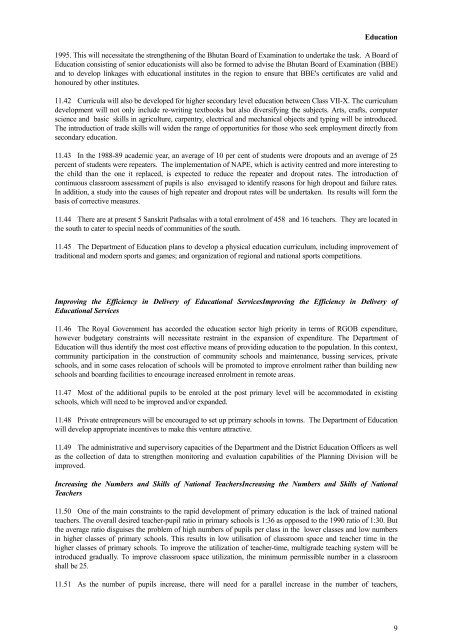COUNTRY BACKGROUND - Gross National Happiness Commission
COUNTRY BACKGROUND - Gross National Happiness Commission
COUNTRY BACKGROUND - Gross National Happiness Commission
Create successful ePaper yourself
Turn your PDF publications into a flip-book with our unique Google optimized e-Paper software.
Education<br />
1995. This will necessitate the strengthening of the Bhutan Board of Examination to undertake the task. A Board of<br />
Education consisting of senior educationists will also be formed to advise the Bhutan Board of Examination (BBE)<br />
and to develop linkages with educational institutes in the region to ensure that BBE's certificates are valid and<br />
honoured by other institutes.<br />
11.42 Curricula will also be developed for higher secondary level education between Class VII-X. The curriculum<br />
development will not only include re-writing textbooks but also diversifying the subjects. Arts, crafts, computer<br />
science and basic skills in agriculture, carpentry, electrical and mechanical objects and typing will be introduced.<br />
The introduction of trade skills will widen the range of opportunities for those who seek employment directly from<br />
secondary education.<br />
11.43 In the 1988-89 academic year, an average of 10 per cent of students were dropouts and an average of 25<br />
percent of students were repeaters. The implementation of NAPE, which is activity centred and more interesting to<br />
the child than the one it replaced, is expected to reduce the repeater and dropout rates. The introduction of<br />
continuous classroom assessment of pupils is also envisaged to identify reasons for high dropout and failure rates.<br />
In addition, a study into the causes of high repeater and dropout rates will be undertaken. Its results will form the<br />
basis of corrective measures.<br />
11.44 There are at present 5 Sanskrit Pathsalas with a total enrolment of 458 and 16 teachers. They are located in<br />
the south to cater to special needs of communities of the south.<br />
11.45 The Department of Education plans to develop a physical education curriculum, including improvement of<br />
traditional and modern sports and games; and organization of regional and national sports competitions.<br />
Improving the Efficiency in Delivery of Educational ServicesImproving the Efficiency in Delivery of<br />
Educational Services<br />
11.46 The Royal Government has accorded the education sector high priority in terms of RGOB expenditure,<br />
however budgetary constraints will necessitate restraint in the expansion of expenditure. The Department of<br />
Education will thus identify the most cost effective means of providing education to the population. In this context,<br />
community participation in the construction of community schools and maintenance, bussing services, private<br />
schools, and in some cases relocation of schools will be promoted to improve enrolment rather than building new<br />
schools and boarding facilities to encourage increased enrolment in remote areas.<br />
11.47 Most of the additional pupils to be enroled at the post primary level will be accommodated in existing<br />
schools, which will need to be improved and/or expanded.<br />
11.48 Private entrepreneurs will be encouraged to set up primary schools in towns. The Department of Education<br />
will develop appropriate incentives to make this venture attractive.<br />
11.49 The administrative and supervisory capacities of the Department and the District Education Officers as well<br />
as the collection of data to strengthen monitoring and evaluation capabilities of the Planning Division will be<br />
improved.<br />
Increasing the Numbers and Skills of <strong>National</strong> TeachersIncreasing the Numbers and Skills of <strong>National</strong><br />
Teachers<br />
11.50 One of the main constraints to the rapid development of primary education is the lack of trained national<br />
teachers. The overall desired teacher-pupil ratio in primary schools is 1:36 as opposed to the 1990 ratio of 1:30. But<br />
the average ratio disguises the problem of high numbers of pupils per class in the lower classes and low numbers<br />
in higher classes of primary schools. This results in low utilisation of classroom space and teacher time in the<br />
higher classes of primary schools. To improve the utilization of teacher-time, multigrade teaching system will be<br />
introduced gradually. To improve classroom space utilization, the minimum permissible number in a classroom<br />
shall be 25.<br />
11.51 As the number of pupils increase, there will need for a parallel increase in the number of teachers,<br />
9

















